Pothos (Epipremnum Aureum) are exceptional vining or trailing plants that are ideal for hanging baskets due to their long cascading vines. They are known by many other names such as money plant, devil’s vine, silver vine, or devil’s scream. This climbing plant can reach several meters in height if you provide it with all the essential needs and a climbing surface. This low-maintenance and easy-to-care Pothos plant is very rich in varieties and all the varieties of Pothos have long and heart-shaped leaves. Let’s explore all the unique types of Pothos for your garden.
Jessenia | Pothos varieties
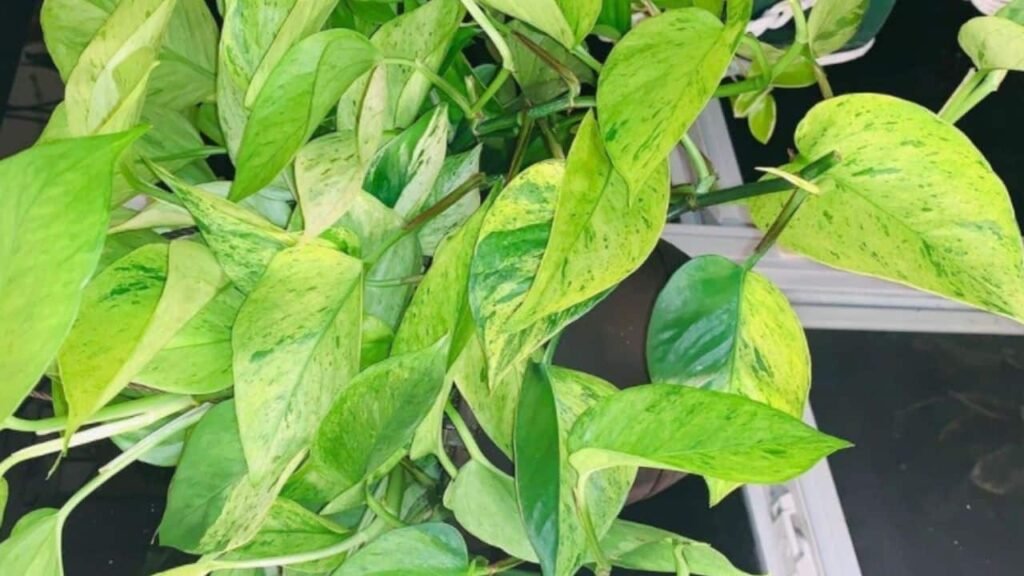
Jessenia is one of the newest varieties of Pothos plants. They resemble Marble queen Pothos and were discovered in 2014 by Costa farms. It has greenish-yellow and heart-shaped leaves with pointed edges. It is a slow-growing Pothos due to a shortage of chlorophyll.
How to Grow and Care for Jessenia Pothos?
- Jessenia Pothos performs very well in bright indirect light but can cooperate with medium light. Avoid it from direct sunlight because it can burn its natural beauty. It can’t tolerate low light because it may cause sluggishness in its growth.
- Jessenia Pothos are good drought-tolerant plant, it can tolerate a lack of watering. Water it when the top 2 to 3 inches of soil dry out. Don’t water it during the fall and winter seasons.
- Apply a balanced liquid fertilizer once a month during the active growing season (spring and summer) and avoid fertilizing it during the fall and winter seasons.
- It prefers well-drained potting soil and warm and humid conditions.
Marble Queen Pothos
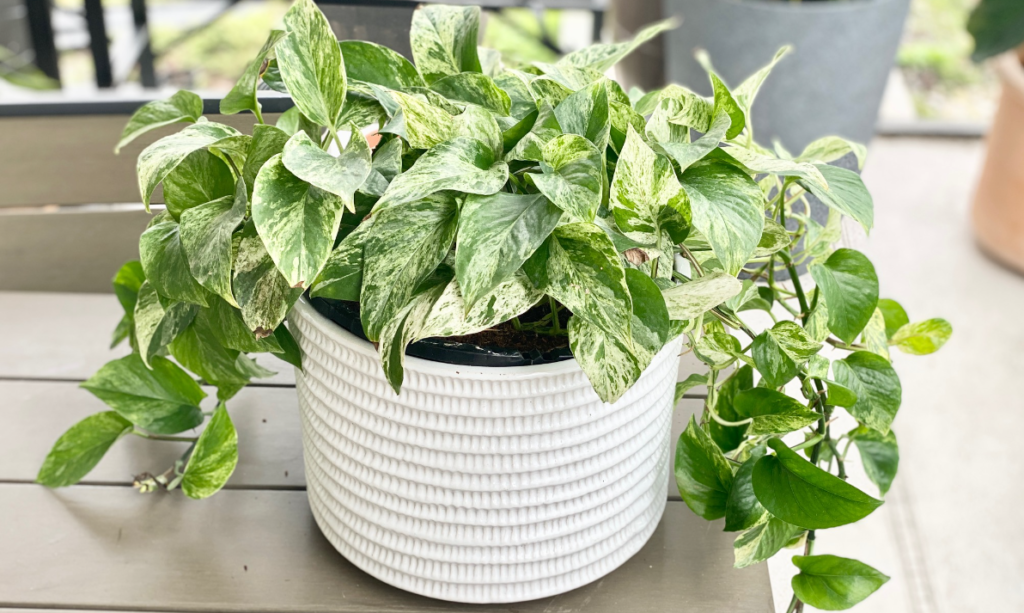
Marble Queen is one of the elegant and popular varieties of the Pothos family. It is characterized by striking green and pale yellow variegation, and its heart-shaped waxy leaves and long trailing vines make it a delightful hanging plant for your kitchen. If you are looking forward to adding the shortest variety of Pothos in your small kitchen space, Marble Queen Pothos will meet your need and drams. It is native to French Polynesia and is toxic for your fur babies and crawling children if ingested. You feel sluggishness in its growth process like other varieties of Pothos due to a deficiency of Chlorophyll.
How to grow and care for Marble Queen Pothos?
- Place the right plant in the right place is a top secret to healthy and energetic indoor plants. Marble Queen Pothos prefers bright indirect sunlight to thrive. Keep it away from direct sunlight because it may scorch this beautiful foliage.
- Allow the top 2-3 inches of soil to dry out between watering. If you notice green leaves turn yellow, it is a sign that your green friend’s face overwatering.
- If you would like to grow Marble Queen Pothos faster, fertilize it regularly during the active growing season.
- Pothos don’t like utterly dry and wet feet because this can also lead to rooting out
Snow Queen | Pothos varieties

Snow Queen Pothos is a very unique and cutest variety of Pothos and is native to Southeast Asia. Its appearance is astonishingly similar to Marble Queen Pothos. Even a colossal number of people get muddled between Marble Queen and Snow Queen Pothos. But it is not rocket science, the easiest and fastest way to determine the difference between both Pothos is to look at the intensity of colors on leaves. Marble Queen Pothos have green and pale yellow leaves while Snow Queen Pothos have green and creamy white leaves.
How to grow and care for Snow Queen Pothos?
- Snow Queen Pothos appreciates the direct light of the morning sun while the bright indirect light of the harsh afternoon sun.
- It can do well in a mixture of perlite or coco coir well-drained soil because perlite helps to make the drainage system better while coco coir is an exceptional alternative to peat moss that retains moisture.
Pothos Neon

Pothos Neon is not only popular among the Pothos family but also unique among any other houseplants. It features bright glossy green and yellow heart-shaped leaves with pointed edges. The youngest leaves of Pothos neon shine brighter than the older ones. It comes from the Solomon Islands and earned its name due to its dark green neon leaves. It looks very amazing in hanging baskets or pots.
How to grow and care for Pothos Neon?
- Neon Pothos prefer bright indirect sunlight to thrive. Keep it away from direct sunlight because it may scorch this elegant foliage.
- Neon Pothos appreciate well-drained and moist soil while discouraging soggy and loamy soil.
- Allow the top 2-3 inches of soil to dry out between watering. Drooping or yellow leaves indicates that your plant face overwatering or underwatering if the soil is completely dry.
- Feed your green-hungry plant once a month, especially in summer.
Manjula| Pothos varieties
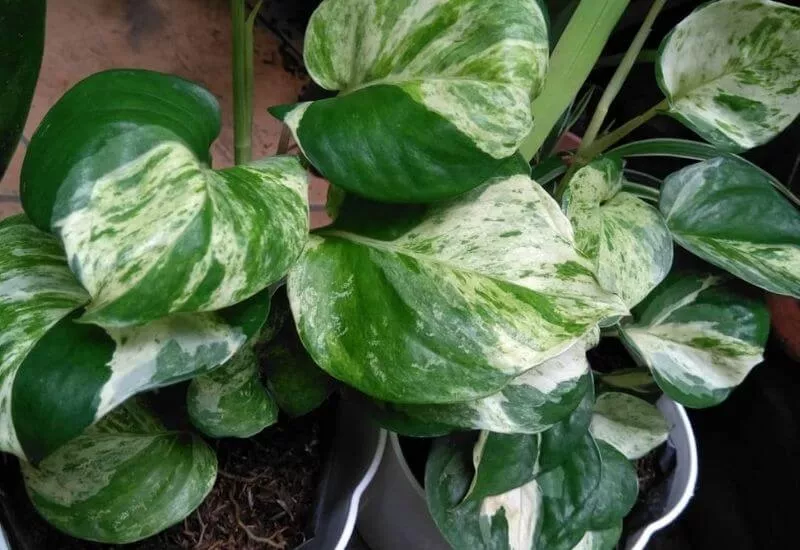
The texture of Manjula Pothos is similar to the jade Pothos. Manjula Pothos is available in various shades like silver, white, creamy, and green. It has heart-shaped small leaves with curved edges. Manjula looks like a lovely baby of Marble Queen Pothos and N’joy Pothos. It is also a proprietary variety originally bred by the University of Florida. They are also known as jewel Pothos and happy leaf Pothos. It is native to Australia. This variety of Pothos is a captivating addition to any kitchen or terrarium.
How to grow and care for Manjula Pothos?
- Bright indirect light is preferable for Manjula Pothos growing. Just make sure to avoid it away from sizzling direct sunlight.
- It loves to sit in loamy, well-drained potting soil with some perlite.
- Water it when the top 2 to 3 inches of soil dry out like other varieties of Pothos.
- This low-maintenance Pothos is not frost-tolerant so, never place it near drafty areas in the winter season.
Pothos Cebu Blue| pothos varieties
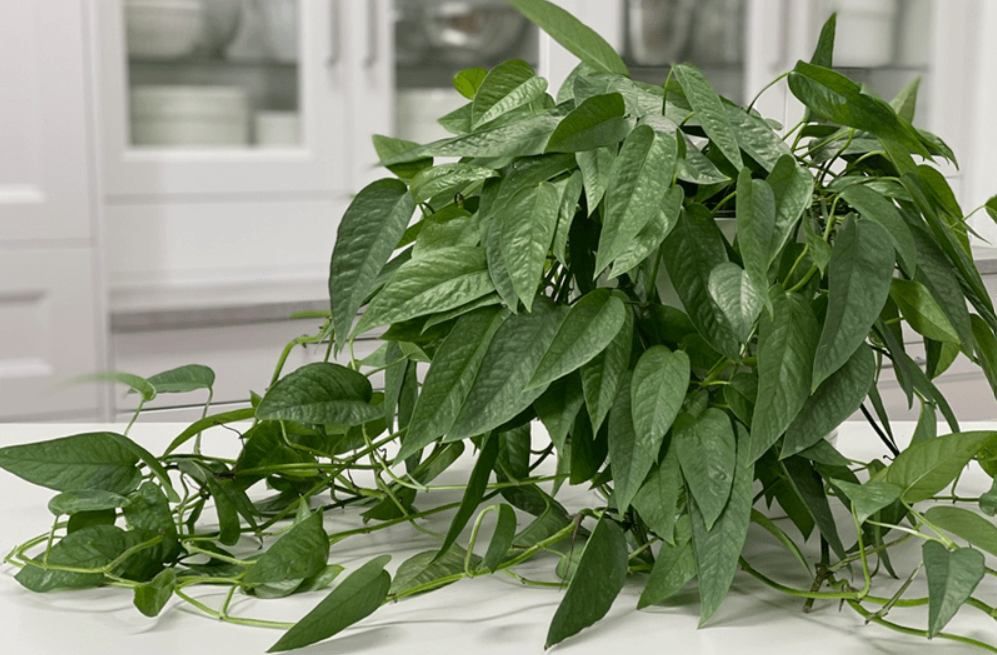
The plant’s young, elongated leaves are small, but as it grows older, it produces leaves that are larger and have fenestrations (as long as it gets plentiful sunlight). Its beautiful bluish-silver-green arrow-shaped leaves with pointed edges make it a unique and stunning variety of Pothos. You never see any varieties of Pothos more beautiful and eye-catching than Cebu blue Pothos. It is very easy to care for and won’t require your full-time attention.
How to grow and care for Pothos Cebu Blue?
- Pothos Cebu blue wants to receive bright indirect light and it will not perform very well in low light. Just make sure to avoid it away from the dazzling rays of the afternoon sun.
- It appreciates well-drained and moist soil while discouraging soggy and loamy soil.
- Water it when the top 2 to 3 inches of soil dry out like other varieties of Pothos.
Golden Pothos | Pothos varieties

These plants come from French Polynesian islands but have naturalized in tropical forests worldwide. Pathos is one of the beginner-friendly houseplants. It has evergreen, waxy, heart-shaped leaves with a splash of golden hue. Pothos will always stay satisfied with the environment if you place it in enough light and do not maintain a high humidity level. They are also known as devil’s ivy because it is hardy.
Its beautiful vines will spread on the walls within a few days and make your kitchen more attractive. You can neglect it for an extended period, and it never takes revenge for it. Don’t worry about managing the light in the kitchen because these plants never stop growing even if you place them in dark or dim light.
N’joy Pothos | Pothos varieties
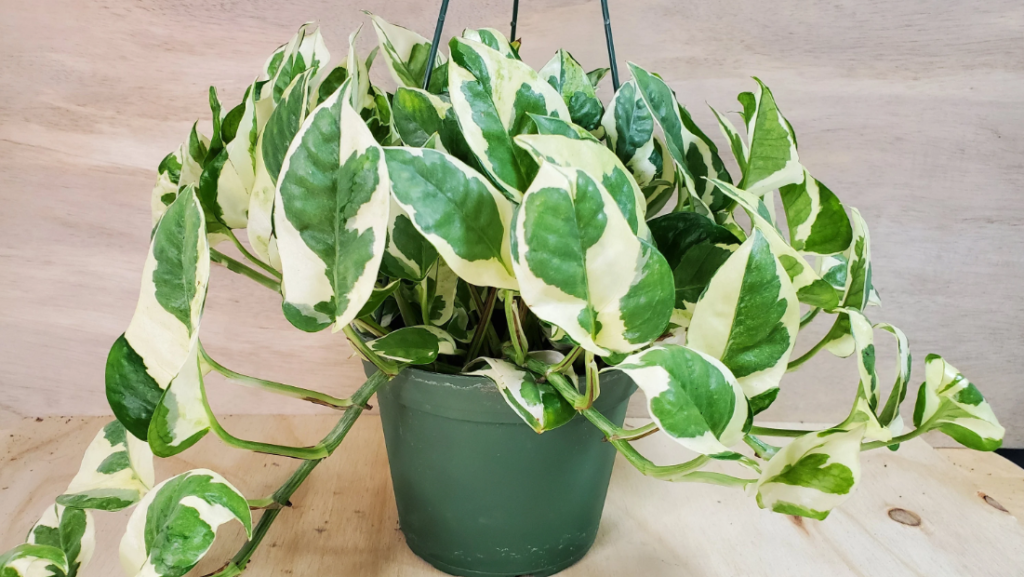
N’joy Pothos is another unique variety of climbing Pothos. The height of this plant can reach up to 10 feet. It is known for its glossy green small leaves with white spots. It needs a lot of bright indirect sunlight to proper growing and become energetic. N’joy Pothos is beloved for its long cascading vines. Pet parents just make sure to keep it away from cats and dogs because it is extremely toxic if ingested it.
How to grow and care for N’joy Pothos?
- Place it where it can receive a sufficient amount of bright indirect light. Don’t keep it in direct light for a long time of period otherwise, it loses its stunning beauty of leaves.
- A mixture of potting soil, perlite, and orchid bark is excellent for the health of N’joy Pothos.
- Allow the top 2-3 inches of N’joy Pothos soil to dry slightly between watering.
- Apply balanced liquid fertilizer once a month during the active growth months ( spring and summer).


